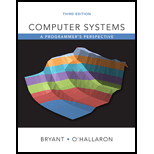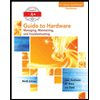
Computer Systems: A Programmer's Perspective (3rd Edition)
3rd Edition
ISBN: 9780134092669
Author: Bryant, Randal E. Bryant, David R. O'Hallaron, David R., Randal E.; O'Hallaron, Bryant/O'hallaron
Publisher: PEARSON
expand_more
expand_more
format_list_bulleted
Question
Chapter 4.5, Problem 4.36PP
Program Plan Intro
Processing stages:
- The processing of an instruction has number of operations.
- The operations are organized into particular sequence of stages.
- It attempts to follow a uniform sequence for all instructions.
- The description of stages are shown below:
- Fetch:
- It uses program counter “PC” as memory address to read instruction bytes from memory.
- The 4-bit portions “icode” and “ifun” of specifier byte is extracted from instruction.
- It fetches “valC” that denotes an 8-byte constant.
- It computes “valP” that denotes value of “PC” plus length of fetched instruction.
- Decode:
- The register file is been read with two operands.
- It gives values “valA” and “valB” for operands.
- It reads registers with instruction fields “rA” and “rB”.
- Execute:
- In this stage the ALU either performs required operation or increments and decrements stack pointer.
- The resulting value is termed as “valE”.
- The condition codes are evaluated and destination register is updated based on condition.
- It determines whether branch should be taken or not in a jump instruction.
- Memory:
- The data is been written to memory or read from memory in this stage.
- The value that is read is determined as “valM”.
- Write back:
- The results are been written to register file.
- It can write up to two results.
- PC update:
- The program counter “PC” denotes memory address to read bytes of instruction from memory.
- It is used to set next instruction’s address.
- Fetch:
Combinational circuits and HCL expressions:
- The computational blocks are been constructed by accumulating several logic gates into network.
- The restrictions are been shown below:
- Each of input for logic gate should be connected to any one shown below:
- One of system inputs, that is recognized as primary inputs.
- Output connection for some element in memory.
- Output of some logic gate.
- Outputs obtained from more than two logic gates could not be linked together.
- The wire would be driven to different voltages.
- It can cause malfunction in circuit.
- The network should not have cycles.
- The loops in circuit can cause ambiguity in function
computed by network.
- The loops in circuit can cause ambiguity in function
- Each of input for logic gate should be connected to any one shown below:
- The “HCL” denotes a hardware control language that is used for describing control logic of different processor designs.
Expert Solution & Answer
Want to see the full answer?
Check out a sample textbook solution
Students have asked these similar questions
Can I get help with this case please, thank you
I need help to solve the following, thank you
reminder it an exercice not a grading work
GETTING STARTED
Open the file SC_EX19_EOM2-1_FirstLastNamexlsx, available for download from the SAM website.
Save the file as SC_EX19_EOM2-1_FirstLastNamexlsx by changing the “1” to a “2”.
If you do not see the .xlsx file extension in the Save As dialog box, do not type it. The program will add the file extension for you automatically.
With the file SC_EX19_EOM2-1_FirstLastNamexlsx still open, ensure that your first and last name is displayed in cell B6 of the Documentation sheet.
If cell B6 does not display your name, delete the file and download a new copy from the SAM website.
Brad Kauffman is the senior director of projects for Rivera Engineering in Miami, Florida. The company performs engineering projects for public utilities and energy companies. Brad has started to create an Excel workbook to track estimated and actual hours and billing amounts for each project. He asks you to format the workbook to make the…
Chapter 4 Solutions
Computer Systems: A Programmer's Perspective (3rd Edition)
Ch. 4.1 - Prob. 4.1PPCh. 4.1 - Prob. 4.2PPCh. 4.1 - Prob. 4.3PPCh. 4.1 - Prob. 4.4PPCh. 4.1 - Prob. 4.5PPCh. 4.1 - Prob. 4.6PPCh. 4.1 - Prob. 4.7PPCh. 4.1 - Prob. 4.8PPCh. 4.2 - Practice Problem 4.9 (solution page 484) Write an...Ch. 4.2 - Prob. 4.10PP
Ch. 4.2 - Prob. 4.11PPCh. 4.2 - Prob. 4.12PPCh. 4.3 - Prob. 4.13PPCh. 4.3 - Prob. 4.14PPCh. 4.3 - Prob. 4.15PPCh. 4.3 - Prob. 4.16PPCh. 4.3 - Prob. 4.17PPCh. 4.3 - Prob. 4.18PPCh. 4.3 - Prob. 4.19PPCh. 4.3 - Prob. 4.20PPCh. 4.3 - Prob. 4.21PPCh. 4.3 - Prob. 4.22PPCh. 4.3 - Prob. 4.23PPCh. 4.3 - Prob. 4.24PPCh. 4.3 - Prob. 4.25PPCh. 4.3 - Prob. 4.26PPCh. 4.3 - Prob. 4.27PPCh. 4.4 - Prob. 4.28PPCh. 4.4 - Prob. 4.29PPCh. 4.5 - Prob. 4.30PPCh. 4.5 - Prob. 4.31PPCh. 4.5 - Prob. 4.32PPCh. 4.5 - Prob. 4.33PPCh. 4.5 - Prob. 4.34PPCh. 4.5 - Prob. 4.35PPCh. 4.5 - Prob. 4.36PPCh. 4.5 - Prob. 4.37PPCh. 4.5 - Prob. 4.38PPCh. 4.5 - Prob. 4.39PPCh. 4.5 - Prob. 4.40PPCh. 4.5 - Prob. 4.41PPCh. 4.5 - Prob. 4.42PPCh. 4.5 - Prob. 4.43PPCh. 4.5 - Prob. 4.44PPCh. 4 - Prob. 4.45HWCh. 4 - Prob. 4.46HWCh. 4 - Prob. 4.47HWCh. 4 - Prob. 4.48HWCh. 4 - Modify the code you wrote for Problem 4.47 to...Ch. 4 - In Section 3.6.8, we saw that a common way to...Ch. 4 - Prob. 4.51HWCh. 4 - The file seq-full.hcl contains the HCL description...Ch. 4 - Prob. 4.53HWCh. 4 - The file pie=full. hcl contains a copy of the PIPE...Ch. 4 - Prob. 4.55HWCh. 4 - Prob. 4.56HWCh. 4 - Prob. 4.57HWCh. 4 - Our pipelined design is a bit unrealistic in that...Ch. 4 - Prob. 4.59HW
Knowledge Booster
Similar questions
- Need help with coding in this in python!arrow_forwardIn the diagram, there is a green arrow pointing from Input C (complete data) to Transformer Encoder S_B, which I don’t understand. The teacher model is trained on full data, but S_B should instead receive missing data—this arrow should not point there. Please verify and recreate the diagram to fix this issue. Additionally, the newly created diagram should meet the same clarity standards as the second diagram (Proposed MSCATN). Finally provide the output image of the diagram in image format .arrow_forwardPlease provide me with the output image of both of them . below are the diagrams code make sure to update the code and mentionned clearly each section also the digram should be clearly describe like in the attached image. please do not provide the same answer like in other question . I repost this question because it does not satisfy the requirment I need in terms of clarifty the output of both code are not very well details I have two diagram : first diagram code graph LR subgraph Teacher Model (Pretrained) Input_Teacher[Input C (Complete Data)] --> Teacher_Encoder[Transformer Encoder T] Teacher_Encoder --> Teacher_Prediction[Teacher Prediction y_T] Teacher_Encoder --> Teacher_Features[Internal Features F_T] end subgraph Student_A_Model[Student Model A (Handles Missing Values)] Input_Student_A[Input M (Data with Missing Values)] --> Student_A_Encoder[Transformer Encoder E_A] Student_A_Encoder --> Student_A_Prediction[Student A Prediction y_A] Student_A_Encoder…arrow_forward
- Why I need ?arrow_forwardHere are two diagrams. Make them very explicit, similar to Example Diagram 3 (the Architecture of MSCTNN). graph LR subgraph Teacher_Model_B [Teacher Model (Pretrained)] Input_Teacher_B[Input C (Complete Data)] --> Teacher_Encoder_B[Transformer Encoder T] Teacher_Encoder_B --> Teacher_Prediction_B[Teacher Prediction y_T] Teacher_Encoder_B --> Teacher_Features_B[Internal Features F_T] end subgraph Student_B_Model [Student Model B (Handles Missing Labels)] Input_Student_B[Input C (Complete Data)] --> Student_B_Encoder[Transformer Encoder E_B] Student_B_Encoder --> Student_B_Prediction[Student B Prediction y_B] end subgraph Knowledge_Distillation_B [Knowledge Distillation (Student B)] Teacher_Prediction_B -- Logits Distillation Loss (L_logits_B) --> Total_Loss_B Teacher_Features_B -- Feature Alignment Loss (L_feature_B) --> Total_Loss_B Partial_Labels_B[Partial Labels y_p] -- Prediction Loss (L_pred_B) --> Total_Loss_B Total_Loss_B -- Backpropagation -->…arrow_forwardPlease provide me with the output image of both of them . below are the diagrams code I have two diagram : first diagram code graph LR subgraph Teacher Model (Pretrained) Input_Teacher[Input C (Complete Data)] --> Teacher_Encoder[Transformer Encoder T] Teacher_Encoder --> Teacher_Prediction[Teacher Prediction y_T] Teacher_Encoder --> Teacher_Features[Internal Features F_T] end subgraph Student_A_Model[Student Model A (Handles Missing Values)] Input_Student_A[Input M (Data with Missing Values)] --> Student_A_Encoder[Transformer Encoder E_A] Student_A_Encoder --> Student_A_Prediction[Student A Prediction y_A] Student_A_Encoder --> Student_A_Features[Student A Features F_A] end subgraph Knowledge_Distillation_A [Knowledge Distillation (Student A)] Teacher_Prediction -- Logits Distillation Loss (L_logits_A) --> Total_Loss_A Teacher_Features -- Feature Alignment Loss (L_feature_A) --> Total_Loss_A Ground_Truth_A[Ground Truth y_gt] -- Prediction Loss (L_pred_A)…arrow_forward
arrow_back_ios
SEE MORE QUESTIONS
arrow_forward_ios
Recommended textbooks for you
 C++ for Engineers and ScientistsComputer ScienceISBN:9781133187844Author:Bronson, Gary J.Publisher:Course Technology Ptr
C++ for Engineers and ScientistsComputer ScienceISBN:9781133187844Author:Bronson, Gary J.Publisher:Course Technology Ptr Operations Research : Applications and AlgorithmsComputer ScienceISBN:9780534380588Author:Wayne L. WinstonPublisher:Brooks ColeCOMPREHENSIVE MICROSOFT OFFICE 365 EXCEComputer ScienceISBN:9780357392676Author:FREUND, StevenPublisher:CENGAGE L
Operations Research : Applications and AlgorithmsComputer ScienceISBN:9780534380588Author:Wayne L. WinstonPublisher:Brooks ColeCOMPREHENSIVE MICROSOFT OFFICE 365 EXCEComputer ScienceISBN:9780357392676Author:FREUND, StevenPublisher:CENGAGE L Systems ArchitectureComputer ScienceISBN:9781305080195Author:Stephen D. BurdPublisher:Cengage Learning
Systems ArchitectureComputer ScienceISBN:9781305080195Author:Stephen D. BurdPublisher:Cengage Learning New Perspectives on HTML5, CSS3, and JavaScriptComputer ScienceISBN:9781305503922Author:Patrick M. CareyPublisher:Cengage Learning
New Perspectives on HTML5, CSS3, and JavaScriptComputer ScienceISBN:9781305503922Author:Patrick M. CareyPublisher:Cengage Learning A+ Guide to Hardware (Standalone Book) (MindTap C...Computer ScienceISBN:9781305266452Author:Jean AndrewsPublisher:Cengage Learning
A+ Guide to Hardware (Standalone Book) (MindTap C...Computer ScienceISBN:9781305266452Author:Jean AndrewsPublisher:Cengage Learning

C++ for Engineers and Scientists
Computer Science
ISBN:9781133187844
Author:Bronson, Gary J.
Publisher:Course Technology Ptr

Operations Research : Applications and Algorithms
Computer Science
ISBN:9780534380588
Author:Wayne L. Winston
Publisher:Brooks Cole

COMPREHENSIVE MICROSOFT OFFICE 365 EXCE
Computer Science
ISBN:9780357392676
Author:FREUND, Steven
Publisher:CENGAGE L

Systems Architecture
Computer Science
ISBN:9781305080195
Author:Stephen D. Burd
Publisher:Cengage Learning

New Perspectives on HTML5, CSS3, and JavaScript
Computer Science
ISBN:9781305503922
Author:Patrick M. Carey
Publisher:Cengage Learning

A+ Guide to Hardware (Standalone Book) (MindTap C...
Computer Science
ISBN:9781305266452
Author:Jean Andrews
Publisher:Cengage Learning